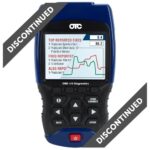When your car’s check engine light illuminates and a scan reveals the error code P0453, it signals a problem within your vehicle’s Evaporative Emission Control System (EVAP). Specifically, this code, applicable to vehicles adhering to both EOBD (European On-Board Diagnostics) and OBDII (On-Board Diagnostics II) standards, points to a “Evaporative Emission System Pressure Sensor High Input”. As an automotive repair expert at autelfrance.com, I’m here to break down what this means, what causes it, and how to approach diagnosis and potential fixes.
This article aims to provide a comprehensive understanding of the P0453 code, going beyond the basics to ensure you’re well-informed. We’ll delve into the function of the EVAP system, the role of the pressure sensor, common symptoms, and actionable diagnostic steps.
Understanding OBD-II Code P0453: Evaporative Emission System Pressure Sensor High Input
The P0453 code is triggered when your car’s Powertrain Control Module (PCM) detects an abnormally high voltage signal from the EVAP pressure sensor. This sensor is a crucial component within your vehicle’s emission control system. Its primary job is to monitor the pressure or vacuum levels within the EVAP system, particularly in the fuel tank.
The EVAP system is designed to prevent harmful fuel vapors from escaping into the atmosphere. It captures these vapors from the fuel tank and directs them to the engine intake to be burned during normal combustion, reducing emissions and contributing to a cleaner environment. The EVAP pressure sensor provides real-time data to the PCM about the pressure conditions within this system. If the sensor reports a pressure reading that is consistently higher than expected, exceeding a pre-determined threshold for a specific duration, the PCM interprets this as a malfunction and sets the P0453 code, illuminating the check engine light.
Symptoms of a P0453 Error Code
While a P0453 code indicates a potentially serious issue within your vehicle’s emission system, the symptoms may not always be immediately obvious to the driver. Here are the common symptoms associated with this code:
- Check Engine Light Illumination: This is the most consistent symptom. The malfunction indicator lamp will light up on your dashboard to alert you to a problem.
- No Noticeable Drivability Issues in Most Cases: Often, the vehicle will drive normally, with no apparent changes in performance or fuel economy. This is because the P0453 code primarily relates to the emission control system and not directly to engine operation in many instances.
- Possible Fuel Odor: In some cases, you might detect a faint fuel odor, especially after refueling or when the vehicle is parked in a garage. This can occur if the EVAP system is not functioning correctly, allowing fuel vapors to escape.
It’s important to note that even if you don’t experience noticeable symptoms beyond the check engine light, addressing a P0453 code is crucial. Ignoring emission system problems can lead to increased pollution, potential fuel wastage, and could indicate underlying issues that may worsen over time.
Causes of P0453 Error Code: Why is the Pressure Sensor Reading High?
Several factors can trigger a P0453 code. Pinpointing the exact cause is crucial for effective repair. Here are the common culprits:
- Defective Fuel Tank Pressure Sensor: The sensor itself may be faulty, providing inaccurate high readings even when the actual pressure within the EVAP system is normal. This is a common cause for P0453.
- Wiring or Connector Issues to the Pressure Sensor: Damaged, corroded, or loose wiring or connectors to the pressure sensor can lead to incorrect signals being sent to the PCM. This can manifest as a high voltage reading, triggering the P0453 code.
- Defective PCM (Powertrain Control Module): In rare cases, the PCM itself might be faulty and misinterpreting signals from a perfectly functional pressure sensor, or incorrectly setting the code. This is less common but should be considered after ruling out other possibilities.
- EVAP System Component Malfunctions: Issues within other EVAP system components, such as a blocked or malfunctioning carbon canister, or a stuck vent valve, can indirectly affect pressure readings and potentially contribute to a P0453 code. While less direct, these issues can create abnormal pressure conditions.
 Shop Image
Shop Image
Alt: Fairway Automotive repair shop in St. Louis, MO, offering expert car repair services.
Diagnosing and Fixing a P0453 Fault: Step-by-Step Approach
Diagnosing a P0453 code requires a systematic approach. Here’s a step-by-step guide for technicians and experienced DIYers:
- Retrieve the OBD-II Code and Freeze Frame Data: Use an OBD-II scanner to confirm the P0453 code and record any freeze frame data. This data provides a snapshot of the vehicle’s operating conditions when the code was set, which can be valuable for diagnosis.
- Inspect the Fuel Tank Pressure Sensor Wiring and Connectors: Visually inspect the wiring and connectors leading to the EVAP pressure sensor. Look for any signs of damage, corrosion, or loose connections. Repair or replace any damaged wiring or connectors.
- Monitor Fuel Tank Pressure Sensor Readings with a Scan Tool: Access the live data stream using your scan tool and observe the fuel tank pressure sensor readings. Check if the sensor is consistently reading high voltage or pressure even when the EVAP system should be at normal levels.
- Test the Pressure Sensor Circuit: Use a multimeter to test the sensor circuit. Verify the presence of a 5-volt reference voltage from the PCM to the sensor, a good ground connection, and a signal return circuit to the PCM. Compare readings to manufacturer specifications.
- Perform a Sensor Function Test: If possible, use a vacuum pump to apply vacuum to the pressure sensor while monitoring the readings on the scan tool. The readings should change accordingly with the applied vacuum. This helps verify if the sensor is responding correctly.
- Check for EVAP System Leaks and Component Issues: Although P0453 is a “high input” code, indirectly related EVAP system issues can contribute. Perform an EVAP system leak test using a smoke machine to identify any leaks. Inspect the carbon canister, vent valve, and purge valve for proper operation.
If, after these steps, the issue remains unresolved, or if you are not comfortable performing these diagnostic procedures, it’s best to consult a qualified automotive technician.
 Shop Image
Shop Image
Alt: CarSmart Auto Service, a certified auto repair shop in Marlborough, MO providing vehicle maintenance.
Common Misdiagnoses to Avoid
When dealing with a P0453 code, it’s easy to jump to conclusions. Here are some common misdiagnoses to avoid:
- Replacing the Fuel Cap: While a loose or faulty fuel cap can cause other EVAP related codes (like small or large leak codes), it’s unlikely to be the direct cause of a P0453 “high input” code.
- Focusing Solely on Purge or Vent Valves: While these valves are part of the EVAP system, they are less likely to directly cause a high input reading from the pressure sensor. Diagnose the sensor and its circuit first.
By following a logical diagnostic process and avoiding these common missteps, you can effectively address the P0453 code and ensure your vehicle’s emission system is functioning correctly. Remember, proper diagnosis is key to an efficient and lasting repair. For expert assistance with P0453 or any other automotive issue, consult with certified professionals at workshops specializing in automotive diagnostics and repair.

